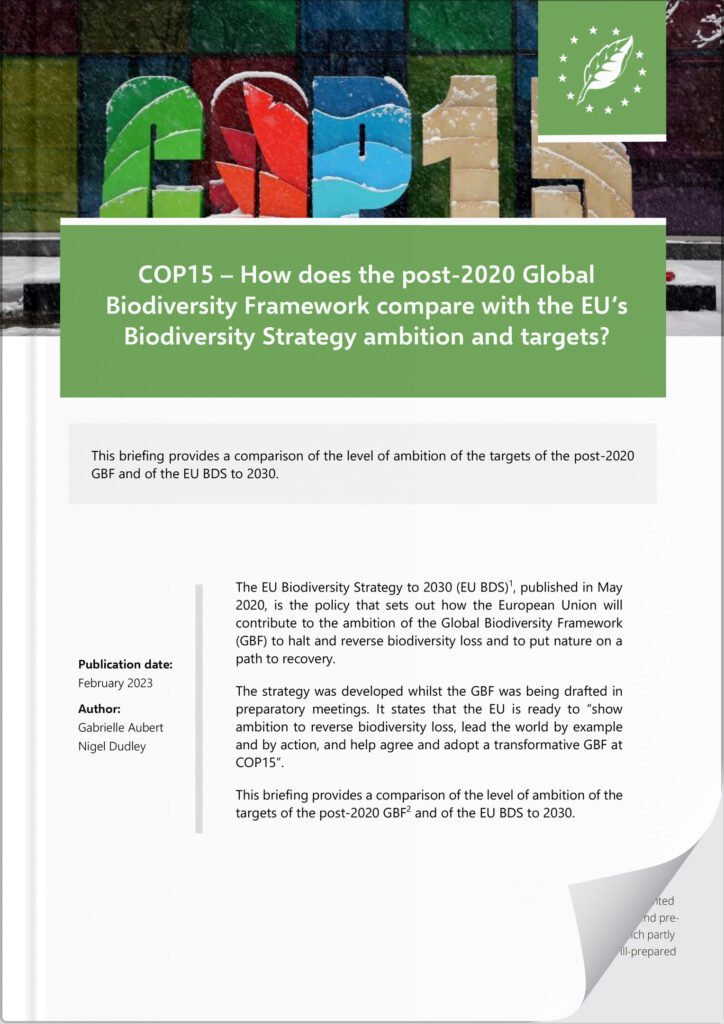AUTHORS: Gabrielle Aubert, Nigel Dudley
This briefing provides a comparison of the level of ambition of the targets of the post-2020 GBF and of the EU BDS to 2030.
On 18 December 2022, world nations agreed on a historic framework based on 4 goals and 23 measures to tackle biodiversity loss and restore natural ecosystems, in the form of the ‘Post-2020 Global Biodiversity Framework’ (GBF)1.
In a previous blog post and podcast, we stressed the need for a robust framework to be adopted and for governments to show as much political will to support biodiversity targets as for the climate targets. We also highlighted the critical role of the EU in the negotiations and in leading the way for other regions, as the EU Biodiversity Strategy to 2030 set out to do.
The GBF is the result of years of hard work and compromises, and a commitment to strong global biodiversity targets. It is regarded by many as “historic”, although until the very last days of negotiations in Montreal there seemed little hope of an agreement being reached.
Overall, the final agreement is ambitious and includes important targets and objectives that will be crucial to creating a nature-positive world. It is flawed in some respects, especially as it remains a voluntary agreement. As has been stated and must be borne in mind, the GBF will “only be as good as its implementation”2.
Quantified, but also clearer, objectives and targets
The GBF includes ambitious quantified objectives and targets in the text, such as the headline targets to restore 30% of degraded terrestrial and marine ecosystems (target 2) and to protect 30% of terrestrial, inland water and of coastal and marine areas (target 3). Although a few of the Aichi targets were also quantified (for example, Aichi target 11 required governments to protect 17% of terrestrial environment and 10% of coastal and marine areas), most were not, and this is recognised as having substantially weakened their impact. The ambitious provisions in the GBF show that it has potential to achieve what the Aichi framework failed to accomplish.
Quantified targets allow for an easier monitoring of progress towards their achievement. Work remains to be done on the indicators to be used to measure progress, but a major step forward was achieved in the agreement as parties will report progress to the CBD twice before 2030, summarised in global trend and progress reports in 2026 and 2029, and followed by high level discussions which should, if necessary, ratchet up commitments and actions.
A voluntary nature, but a strengthened governance and implementation framework
One of the major flaws of the GBF is inherent in its nature. Activists who were expecting a ‘Paris moment for nature’ criticised the softness of the framework which remains voluntary, as was the Aichi framework, and identify serious weaknesses e.g., in the targets for restoration and species conservation3.
The monitoring and reporting framework, which is more robust than the previous one but still not fully developed, will therefore need to be up to the task and NGOs and civil society will need to put enough pressure on parties to report on their progress towards the targets. One element which contributed to the failure of achieving the previous targets was that national targets were poorly aligned with the global targets in scope and ambition. Parties will need to fill that gap and replicate the level of ambition that was shown in Montreal in their national strategies.
Targets 14 to 23 provide the tools and solutions for implementation and mainstreaming of biodiversity into relevant policies. One can only hope that the international community has learned from its past mistakes and will not repeat those made in the previous decade. Each party will have to revise its national strategy and action plan for biodiversity by 2024 and 2026, aligned with global objectives. At each COP, these objectives will be scrutinised and reviewed as part of a global analysis to monitor progress towards the targets by 2030. Countries will then need to submit national reports on implementation in 2026 and 2029, which should allow for monitoring on the basis of indicators and more harmonised monitoring templates.
The GBF can be praised for its strong text on the involvement of Indigenous Peoples and Local Communities (IPLCs) (target 22) and its consideration of gender equality (target 23), which are crucial elements of public participation into biodiversity conservation. The recognition of the rights of IPLCs is a clear victory for Indigenous activists as it recognises their contribution to protecting biodiversity and helps reduce the risk of being evicted from their traditional lands and waters.
New GEF fund with (real) additional EU funding
Financing the delivery of a nature-positive future remains an issue. This point of tension was at the core of the negotiations and was one of the reasons why the agreement was almost not concluded. Countries of the global south were asking for the creation of a dedicated biodiversity fund and for financial transfers of up to $100 billion per year. A compromise was found in the form of target 19, which commits developed countries to transferring at least $20 billion per year by 2025 and at least $30 billion per year by 2030 to developing countries. In total, at least $200 billion per year must be mobilised by 2030 from all sources. The biodiversity financing gap is estimated at $700 billion per year4, which the GBF will attempt to bridge by also committing to reducing harmful subsidies by $500 billion per year (target 18).
Another compromise was the creation of a Special Trust Fund under the auspices of the Global Environment Facility (GEF), which will be established by the end of 2023 and be operational until 2030. The fund would complement existing support and scale up financing to ensure the timely implementation of the GBF.
The European Commission has confirmed its doubling of EU’s international biodiversity financing to €7 billion for 2021-2027 for developed countries. Several Member States have also doubled their financial support, such as France which has committed to €1 billion per year by 2025 and Germany €1.5 billion by 2025 to €6 billion annually by 20255. Germany has committed €29 million to the NBSAP Accelerator Partnership, an initiative to support developing countries to quickly develop their new national biodiversity strategy or action plan in line with the GBF.
The EU will be expected to strongly support developing countries in terms of financial and technological transfers and capacity building (target 20). Implementing its own Biodiversity Strategy to 2030 will also require extensive resources. Its efforts in protecting biodiversity within the continent can provide lessons and best practices for countries outside of it as well.
References
1. https://www.cbd.int/article/cop15-cbd-press-release-final-19dec2022
4. https://www.paulsoninstitute.org/conservation/financing-nature-report/


